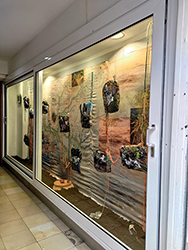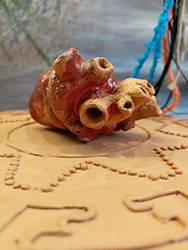"Ese Retumbar". Installation. LANDMANN-31 - Cologne, Germany, 2024
Photos and map of the Río de la Plata,
images of ceramics set in the landscape of the Paraná delta, cushioned with volume and woven into a net.
and woven into nets. Ceramic heart and plate.
Sound of the Río de la Plata recorded in the Parque de la Memoria, voices in three languages: Querandí, Spanish and German.
...like the sound of the drums that still resound when I walk through Buenos Aires, my city: I have always imagined what this land was like before the arrival of the Europeans, I feel the presence of the indigenous people, the querandíes. I see the grasslands and forests along the streams, the deer in the marshes, the birds, the mosquitoes. I also hear and see the horses and the cows... like a rumble before colonisation bursts in, shattering regional life... forever. I mould ceramics from the earth, which in turn I let touch the earth and photograph in this symbiosis. Textiles printed with these symbiotic photographs float on a background of an old map of the Río de la Plata with images of its waters. Coloured threads weave a web. The background merges with the earth on the ground.
A heart is the soul of the earth, Soychu. Querandí, Spanish, German, these are the three languages that intertwine in the sound of ‘Dieses Pochen’. For me, exhibiting in Germany is a return to my own family history, I carry my ancestors and my own life on my back.
There are invisible threads in space-time that connect Germany with Argentina, Europe with America, my family history and the history of my ancestors: the Holocaust of the Jewish people and the ethnocide of the Native Americans.
Rita Simoni
Cartography of a vibrating heart-territory
Rumbling is an enduring sound that penetrates the collective memory. In Rita Simoni's work, this concept comes to life in an installation that vibrates with the force of heartbeats and historical persistence. Through a fusion of artistic disciplines, Rita invites us to listen to the echoes of a past that continues to resonate in the present, especially in the history of the Querandí people; native to the territory we now call Argentina. For Rita, art beats, pulsates and insists. Her intuitions, like heartbeats, are transformed into works that rumble. While the beat is constant and almost imperceptible, the rumble is a powerful, albeit ephemeral, manifestation. In "Ese retumbar" (That Rumble), the artist stages this duality, inviting us to reflect on historical persistence and the importance of keeping the voice and memory of indigenous peoples alive.
The Querandí people, one of the first inhabitants of Argentina in the region that is now known as the province of Buenos Aires, are the central focus of her work. Through sounds, images and objects, Rita Simoni leads us to listen to the echoes of their culture and to reflect on their legacy. The work emphasizes the importance of keeping the memory of these peoples alive and recognizing their contribution to the cultural history of the country. Following the prominent Indian intellectual Gayatri Spivak, this action is interpreted as a way of decolonizing sound, recovering silenced voices and reclaiming orality as a mode of knowledge and cultural transmission.
As occurs in these southern lands, where its inhabitants are a mixture of different origins, "Ese retumbar" is also made up of combinations; as a transdisciplinary piece, it fuses photography, soft sculpture, painting with threads, ceramics and sound design to create a sensory sign that intertwines the ancestral and the contemporary. This transdisciplinarity allows for the construction of a complex and multifaceted story that addresses issues such as identity, memory and social justice in connection with the territory. If we start from the notion that our language shapes our perception of the world, we could take the words heard in “Ese retumbar” as a metaphor for the arbitrary fragmentation suffered by the Querandí people. Words that point to the territory – we are the water; we are the fire; we are the earth; we are the wind – and connect us with the deepest roots of our identity; one made of arrogance and silencing but also of recovery and unbreakable resilience, like that of the river that, despite droughts and floods, always finds a way to move forward. The Querandí language, despite attempts to silence it, continues to flow and enrich our culture.
“Ese retumbar” is much more than a work of art. It is an invitation to reflect on our history, recognize cultural diversity and commit to building a more just and equitable future. The rumble of history continues to resonate in our ears, reminding us that the past is not forgotten and that its legacy remains present in the now. The impossibility of translating the title into German highlights the uniqueness of the cultural experience and the importance of preserving linguistic diversity. By integrating the perspective of Spivak, who writes from the Global South, we seek to underline how Rita Simoni’s work goes beyond mere artistic representation. It becomes a political and social act, a way of resisting and transforming the power structures that have silenced indigenous peoples. The work invites the viewer to reflect on their own role in building a more just and equitable society.
Mariana Rodríguez Iglesias, Curator.
Una obra viajera y mil historias más en la obra de Rita Simoni, por Melisa Boratyn, Revista Zibilia, 06/09/2024
Kartographie eines Herzens Gebiets, das vibriert, köln insight, 2024














